Hello,
just a quick update: you can take part in giveaway until 5. January 2011, 23:59 GMT.
Winner will be announced on the next day.
There is also a possibility to double your chance of winning, so check out the original giveaway post.
Have a nice weekend!
Thursday 30 December 2010
Saturday 25 December 2010
Happy Christmas + giveaway!
Dear readers,
I hope you are all having happy holidays.

I hope you are all having happy holidays.

On this special holiday I am giving away one pair of handmade stud earrings from my collection Snow is falling, which is also available in my shop. The winner gets to choose: pair A or pair B.
If you would like to take part in this giveaway leave a comment on this post and tell me what were you doing on Christmas evening.
EDIT: You have until 5. January 2011 23:59 GMT to participate. The winner will be known on 2. January 2011.
To double your chance of winning this cute pair of earrings, post about this giveaway on your blog, and post a link to it in a comment.
Good luck! ;)
Wednesday 22 December 2010
Long time no post
I'm sorry I haven't posted anything in the last month. I was working a lot, but I did manage to finish my coat anyway. Hopefully, you will see it in the next few days. :)
I have some great news:
1. I will be hosting a giveaway for Christmas! One lucky winner will get a piece of my own handmade jewelry. If you don't want to miss this opportunity, follow my blog.
2. I am a featured member at BurdaStyle! Click and read the full interview.

I have some great news:
1. I will be hosting a giveaway for Christmas! One lucky winner will get a piece of my own handmade jewelry. If you don't want to miss this opportunity, follow my blog.
2. I am a featured member at BurdaStyle! Click and read the full interview.

Wednesday 24 November 2010
How to underline a garment
Underlining reinforces open weaves, prevents transparency and adds support. It is basted 1.3 cm (1/2 in.) wide to shell prior to sewing and acts as a single layer. Seam allowances of underlining are then optionally trimmed to the stitched line to prevent bulk. If you want extra support or to protect critical areas that will receive a lot of stress from being bent and sat on (elbows, rumps), hand baste underlining to the body of shell parallel to the grain of fabric.
Broadcloth, muslin, fine cotton batiste, china silk, silk organza, cotton/silk batiste blend, cotton flannel or fusible interfacing can be used to underline a garment. If you use fusible interfacing as underlining, fuse it to shell proir to sewing. Seam allowances are optional.
I used cotton flannel, which will not only add support to my shell fabric, but also make the coat warmer.
I used cotton flannel, which will not only add support to my shell fabric, but also make the coat warmer.
1. Your pattern pieces should already be interfaced. I did a quick tutorial on this in the previous post.
2. Cut underlining pieces in the same size as pattern pieces. You don't have to underline pieces which are already interfaced. In any case, don't underline collars, lapels, pocket flaps, cuffs, etc.; those areas are usually interfaced.
3. Place the wrong side of underlining to the wrong side of shell fabric and pin it in the middle, parallel to the grain of the fabric.

4. Now it is time to adjust underlining for turn of cloth. That is the amount of space taken up by fabric's thickness when folded. This has to be done, if you want to avoid bulking of the underlining when you sew the pieces together and press the seam allowances apart. So, place your hand over pins, fold fabric over hand (underlining's overlap shows amount of adjustment needed for turn of cloth), then pin fabric and underlining near adjusted edges. Average turn of cloth will be 0.3 to 0.6 cm (1/8 to 1/4 inches) or more, if your fabric is thicker.

5. Trim underlining to the edge of shell fabric. Pin the other sides to shell as well.

6. Stitch underlining to shell fabric 1.3 cm (1/2 in.) wide with a basting stitch.

7. Optional: to prevent bulk in seams, trim underlining to the stitched line.
8. For extra support: draw lines 2 to 3 cm (3/4 to 1 1/8 in.) apart parallel to the grain of the fabric and hand baste underlining to shell fabric along the lines with stitches 2.5 to 3.5 cm (1 to 1 1/2 in.) long.

9. Trace over pattern's marks for pleats, buttonholes, darts, etc., and sew underlined pieces into a garment.
Thursday 18 November 2010
Interfacing a garment
Interfacing gives support and shape to e.g. collars, lapels, facing, cuffs, ... It is available as a sew-in fabric or a fusible fabric, woven or nonwoven. It is cut in the same size as pattern pieces and fused or basted directly to the shell fabric. Seam allowance is required for nonfusible interfacing and optional for fusible interfacing.
For a coat, usually the following pieces should be interfaced:
- front + front facing
- side front (if there is a pocket on the princess seam)
- upper back (shoulder area) + back/neck facing
- neckline and armhole seam allowances
- hems
- collar, lapel
- buttonhole areas
- pocket areas, pocket flaps, cuffs, waistband
For my coat, the pattern required to interface a coat front (including front facing) and front side, neck facing, and seam allowances on the neckline and armholes. I decided to use fusible interfacing, because it is much quicker to iron than sew on by hand. I used this one:
1. Preshrink both shell fabric and interfacing and cut the pattern pieces. Seam allowances are optional for fusible interfacing. Put a pressing cloth on the ironing board (to protect the ironing board). Place a piece of shell fabric down on it.

2. Place the adhesive side of the interfacing to the wrong side of the shell fabric. Ahesive side is usually a bit rough.

3. Place a pressing cloth over the fabric and interfacing (to protect the iron from getting dirty with interfacing's resin). Fuse the interfacing according to manufacturer's instructions. I, e.g., had to iron a piece on middle-high heat without steam. Some interfacings require steam.

4. Place the interfaced piece on an even grounding and leave it there to cool down.
5. Now, it is time to underline the shell fabric. Only after that you can trace over pattern's marks for pleats, buttonholes, darts, etc., and sew the pattern pieces into a garment.
I will be showing you how to underline a garment very soon!
Saturday 13 November 2010
Coat construction
I want a warm coat, so I did a little research on coat/jacket construction. There are 5 different fabric layers, each one has it's own purpose. Usually, 3 or 4 of them are used.
1. shell: the outer layer
- fashion fabric
2. underlining: reinforces open weaves, prevents transparency and adds support
- broadcloth, muslin, fine cotton batiste, china silk, cotton/silk batiste blend, cotton flannel, fusible interfacing
Underlining is stitched 1.3 cm (1/2 inch) wide to the shell prior to sewing and acts as a single layer. The seam allowances of the underlining are then trimmed to the stitched line to prevent bulk. If you want extra support or to protect critical areas that will receive a lot of stress from being bent and sat on (elbows, rumps), hand baste the underlining to the body of the shell parallel to the grain of the fabric.
If you use fusible interfacing as an underlining, fuse it to the shell proir to sewing. Seam allowances are optional.
Tip: cotton flannel not only adds support, but also insulates. That means you can omit the interlining, but still have a warm garment.
3. interfacing: gives support and shape to e.g. collars, lapels, facing, cuffs, ...
- fusible/nonfusible interfacing
It is fused/hand basted directly to the shell. Seam allowance is required for nonfusible interfacing and optional for fusible interfacing.
Tip: when a garment is underlined, interfacing may not be necessary, because both the garment and the facing sections are underlined. So the two layers of underlining between the garment and the facing provide an adequate interfacing. Or if I put it like that: the pattern pieces that are interfaced, don't have to be underlined.
4. interlining: adds insulation
- cotton flannel, lambswool interlining, lightweight thinsulate, thin microfleece, chamois
It is made from the lining pattern; collars, pockets, double-breasted section, belts etc. are not interlined.
Interlining is stitched 1.3 cm (1/2 inch) wide to the lining individually and acts as a single layer. The seam allowances of the interlining are then trimmed to the stitched line to prevent bulk.
5. lining: a finishing layer that covers the inside construction of the coat
- satin, tafetta, twill, jacquard, bemberg rayon, silk, polyester, acetate, flannel back satin
Tip: flannel satin serves both as a lining and adds insulation. That means you can omit the interlining, but still have a warm garment.
I hope this helps. ;)
I am slowly making progress on my coat. The fabric is cut, now I have to put the pieces together. In the next post I will be showing you how to underline and interface the garment.
Have a nice day!
I am slowly making progress on my coat. The fabric is cut, now I have to put the pieces together. In the next post I will be showing you how to underline and interface the garment.
Have a nice day!
Saturday 6 November 2010
Ring pincushion
I used to have only one pincushion and it was kind of annoying, because I had left it on the floor, under some fabric scraps, on the other side of the table, ... , while I was already by the sewing machine, in need of my pincushion. It was never there, when I needed it. Actually, what I really needed, was a finger pin cushion. I wanted one for a pretty long time, but I didn't like those that you make out of the bottle cap. So, I made my own variation, which I really like. I made a tutorial just for you!
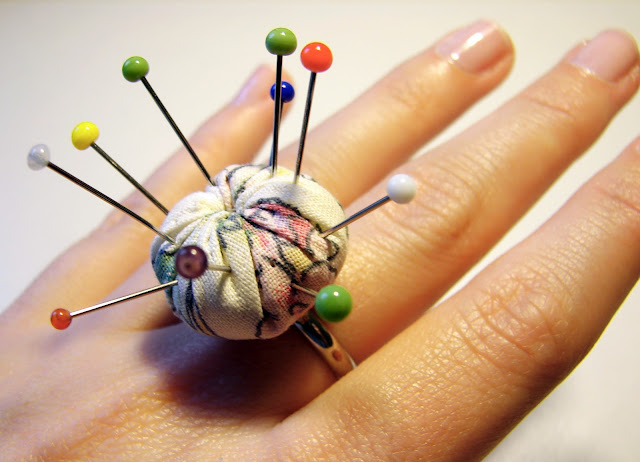
You need:
- fabric scraps
- thread + needle
- toy filling
- ring with a plate
- contact rubber adhesive
1. Cut a circle with 3.5 cm radius. Sew a running stitch with a double thread 1 cm away from the edge. The thread ends should come out on the right side of the fabric.

2. Pull the threads and put some filling into the middle of the wrong side of the fabric circle.

3. Tie the threads together as shown.

4. Pull the threads a little bit more.

5. Push the seam allowances inside the sack and tighten the threads.

6. Stuff the ball with more filling. Help yourself with one end of the seam ripper. The ball should not be too soft.


8. Thread the needle with both thread ends and push the needle into the ball, where the knot is.

9. Pull the needle out on the other side of the ball and cut the thread.


10. Glue the ring plate and the plain side of the ball with contact rubber adhesive. Wait for 7-10 minutes, then push the two parts together and wait to dry.

11. Done!

Labels:
ring pincushion,
sewing,
tutorial
Friday 29 October 2010
Making a coat
It is high time to sew a coat and I am making this one:
I love that it is collarless, the buttons are invisible, it has a band to accentuate the waist, and it is slightly gathered at the waist. The pattern is made for short misses, I hope it will fit, because I won't be making a test coat. I will be posting about different stages of making it. I am so excited to see it done! :)
I have never made a coat before. Have you?
Monday 25 October 2010
Crochetie's faux fur earmuffs giveaway!
My fellow-blogger, Crochetie, is hosting a giveaway. One lucky reader will get these cosy faux fur earmuffs - of his own colour choice! You can choose amongst ivory, grey and brown.
Labels:
giveaway
Sunday 24 October 2010
How to sew an exposed zipper
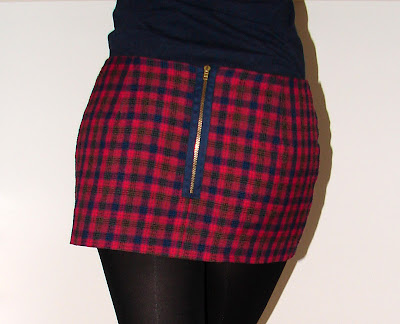
Exposed zippers have been quite popular lately, so I decided to make a tutorial on how to sew them. You will need an unfinished garment, a (metal) zipper and some fusible interfacing.

1. Iron 2.5 cm wide fusible interfacing to the right side of both zipper seam allowances. The interfacing should be 0.5 cm shorter than the full length of the zipper. Mark a line, where the zipper ends.

2. Staystitch (length of a stitch is approximately 1.8-1.9 mm) along the edge, 1.9 cm wide. When you come to the drawn line, turn the fabric for 90 degrees and sew off the edge.

3. With the right sides together, stitch the seam below the zipper opening, 1.5 cm wide.
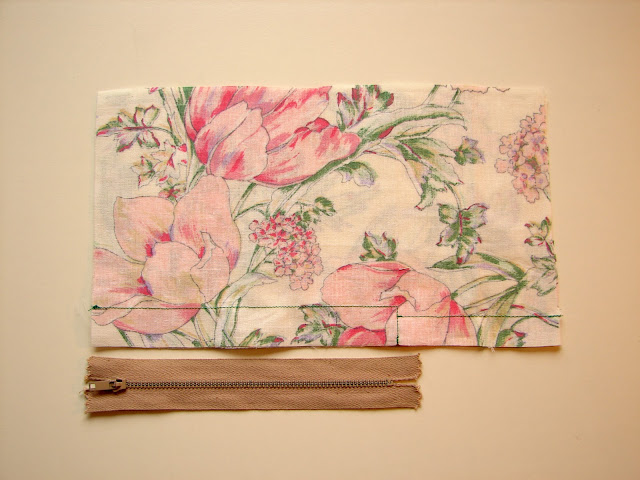
4. Cut a notch diagonally into the seam allowances of the zipper base, but be careful not to cut the staystitching. I recommend you to cut into each seam allowance separately.

5. Fold and press the triangles along the staystitching to the wrong side of the seam allowances below the zipper.

6. Press open the seam allowances below the zipper opening.

7. Turn the zipper seam allowances to the right side along the staystitching and press.

8. Place the zipper on the right side of the fabric. Make sure that the zipper teeth are not covered with the fabric on the wrong side. Fold the raw ends of the zipper under the zipper and pin. Baste the zipper to the seam allowances only, 1 mm away from the teeth.


9. Use a zipper foot and stitch the zipper to the seam allowances along the basting, 1 mm away from the teeth, on both sides. Don't forget to backstitch. Use a thread in the same colour as the zipper tape (I used green for you to see the stitching). Remove the basting thread.

10. Trim the seam allowances, so they do not extend beyond the zipper tape.
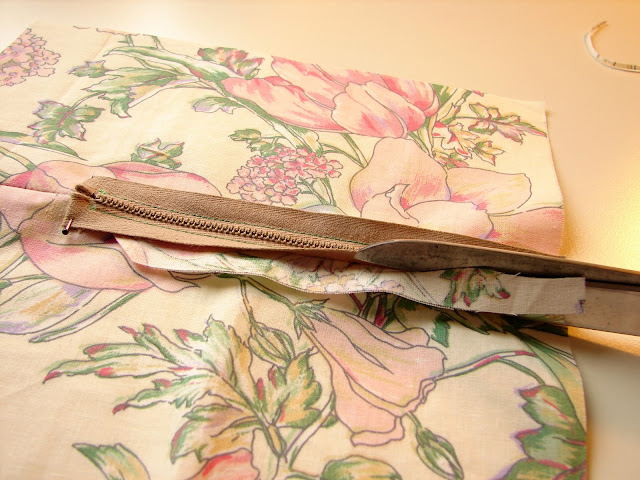
11. Edgestitch the zipper in place from top to bottom on one side, sew across the zipper base to secure, and edgestitch from bottom to the top on the other side of the zipper.
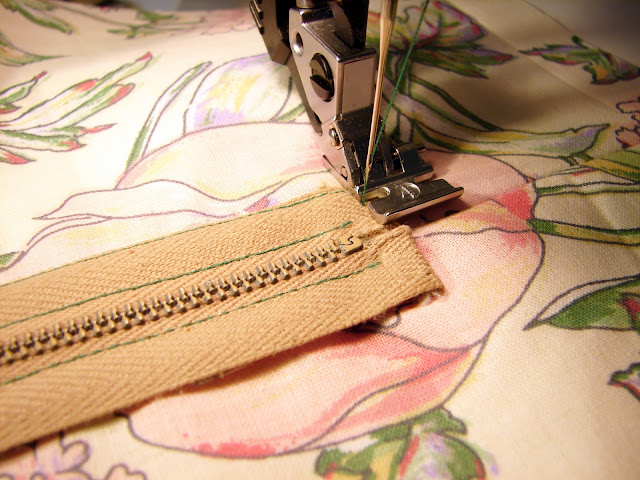
12. Finished!
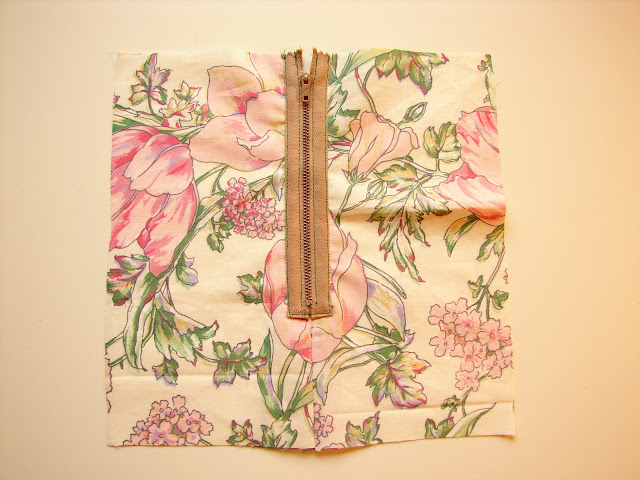

Labels:
inspiration,
sewing,
tutorial
Subscribe to:
Posts (Atom)







